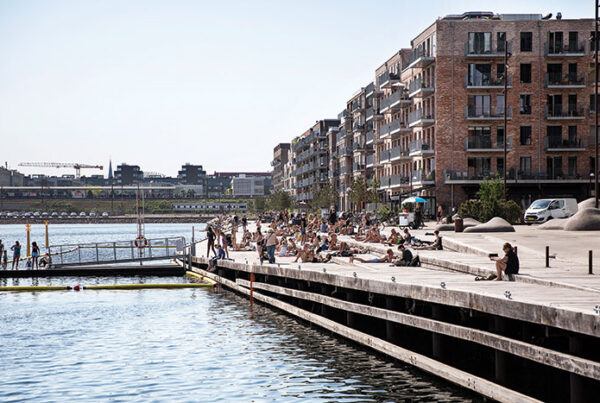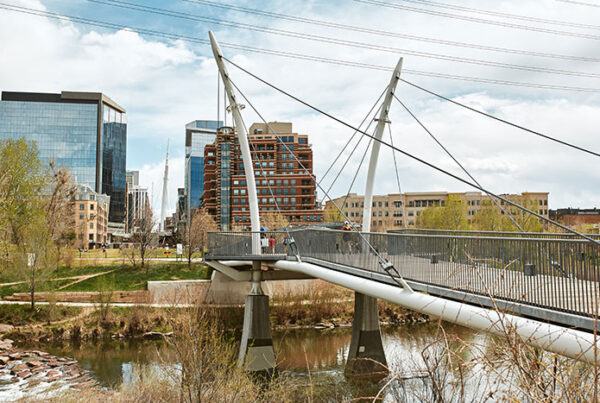
This alley near Bradley Plaza in Los Angeles’ Pacoima area has been transformed into a pedestrian friendly green space by adding amenities and closing off to car traffic. (Trust for Public Land)
Pacoima is one of the oldest neighborhoods in Los Angeles. In its early years, it was known as an agricultural community that was subject to constant flooding. To address this issue, the city of Los Angeles implemented various flood control measures. In the early 1940s, Pacoima became a destination for heavy industry and the families of workers supporting the war effort—changing the character of the community. Many of these families lived near factories that are now listed as some of the most polluted sites in the United States. The area’s long history of environmental neglect gave rise to Pacoima Beautiful, a nonprofit organization founded by five mothers from Pacoima who wanted to create a safer and cleaner community for their children through collective action.
Since 1997, Pacoima Beautiful has worked with the community to reclaim open areas and create beautiful recreational spaces throughout the neighborhood. In 2010, the organization published the Pacoima Urban Green Vision Plan to create a healthier and more sustainable community. One of its first completed projects, the Bradley Plaza Green Alley, transforms an underused alleyway into a green public space and reimagines how alleys can be repurposed to best serve the communities in which they are situated. The project team, composed of the City of Los Angeles Department Sanitation and Environment; the Trust for Public Land; Pacoima Beautiful; and global engineering firm Arup as the lead designer and engineer of record, prioritized their partnership with the community. The design delivered a project that serves the community, beautifies the space, and builds resilience through improved stormwater infrastructure that far exceeds performance requirements.
From the beginning of the project, the team sought insights from the community and involved them in the design process. A key example is, at a design charrette, the community provided input for the three concepts that the team had developed. This enabled the team to learn important feedback—namely, that the community wanted the alley to feature better lighting, more shade, landscaping, and interactive play and exercise elements. The subsequent design featured the key elements that the community prioritized, while remaining true to the culture and character of Pacoima.

Images of the alleyway before it was reimagined. The alley continues to serve as drainage from flash flooding. (Trust for Public Land)
Transforming the Alley
Incorporating the Bradley Avenue Plaza into the project made the plaza the focal point of the space. The goal was to create a cohesive design that could tie in the existing plaza and the new green alley. As a result, most of the recreational equipment and seating elements are concentrated in the plaza.
Improvements to the alley included the removal of the non-ADA-compliant existing sidewalk and the incorporation of shared street signage and traffic controls to promote the shared surface concept. While this concept is common in Europe, this is its first application in Los Angeles. The shared surface concept minimizes segregation between different types of road users, such as pedestrians and cars, while still incorporating pedestrian safety measures like speedbumps and a uniform aesthetic with the plaza that signals to drivers that they are entering a unique and shared space.
The project is intended to create a space that can be used for community gatherings, performances, and outdoor learning. A large shade structure and adjacent seating elements provide a place for performances and gatherings. The ADA-accessible grading design and exercise elements ensure that the space is accessible to all. The project also introduces nature into the city, with over 1,300 plants installed to create shade and reduce the heat island effect. The project’s pavement coloring also has a high albedo characteristic, which reflects solar rays and reduces the absorption of heat.
Building Resilience
Pacoima has historically been subject to flooding from storms. The new design aims to alleviate flooding by sloping the alley toward the southern edge. As it flows downward, the water will move through stormwater planters, then a lined infiltration trench and a drywell system. This multifaceted stormwater management system provides multiple instances of filtration for stormwater that is likely to be polluted from the urban environment. The final design is able to collect and treat stormwater from a 4.5-acre (1.8 ha) watershed with a 2 million-gallon annual rainwater capture capacity.
Reflecting the History and Culture
The project design strives to reflect Pacoima’s history, culture, and vision for the future. In addition, the project team worked closely with the native people of Pacoima—the Tataviam Band of Mission Indians—to incorporate Tataviam symbols of cultural significance and language translation etched onto metal plaques throughout the site.

The alley has been made safer for pedestrian and micro-mobile traffic in areas closed off to automobiles. (Trust for Public Land)
Looking Ahead
The project opened with a virtual ribbon-cutting ceremony in October 2020. Formal programming of the Bradley Plaza Green Alley is pending a full reopening of the city. Future visions for the alley include using it as an outdoor classroom as well as a performance or meeting space for community groups. There also are plans to add elements like a stage and a kiosk when additional funding is available.
More broadly, Los Angeles has roughly 900 miles (1,400 km) of underused alleyways. Bradley Plaza Green Alley has proved that we can reimagine the way that alleys take up city space, especially in communities that lack access to high-quality open spaces. As Bradley Plaza Green Alley illustrates, alleys can be transformed into places that offer community amenities while still serving their stormwater conveyance purpose. Furthermore, best practices for stormwater management can be added to alleys to increase the quality and quantity of stormwater captured.
Bradley Plaza Green Alley demonstrates that alleys have great potential to create more value to the community through improved public health, beautiful green spaces, and increased resilience.
SCOTT RUSSELL is group leader, and VANESSA THOMPSON is a civil and environmental engineer with Arup’s Los Angeles office.



